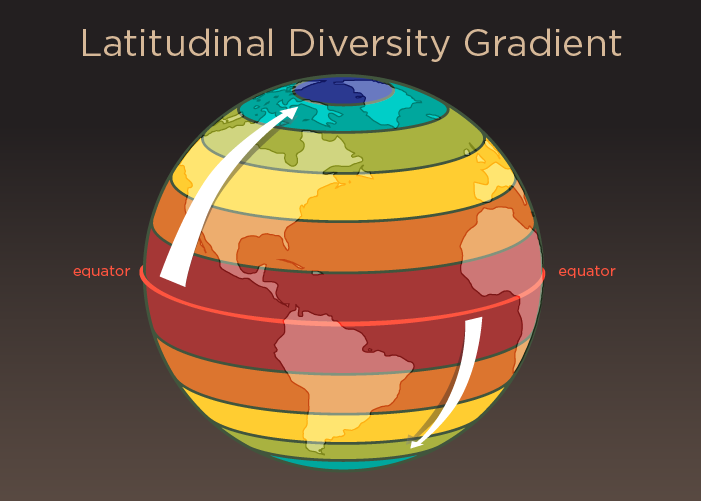Today, plant and animal biodiversity across the globe tends to be highest at the equator and diminishes as one moves to higher latitudes. This pattern, called the latitudinal diversity gradient, has not always existed, new research finds. Credit: Julie McMahon
It's called the latitudinal diversity gradient, a phenomenon seen today in most plant and animal species around the world: Biodiversity decreases from the equator to higher latitudes. A new study of fossils representing 63 million of the past 65 million years reveals that—for North American mammals, at least—the modern LDG is the exception rather than the rule.
The findings, reported in the Proceedings of the National Academy of Sciences, point to the importance of not assuming that the way things are today is the way they've always been, the researchers say.
"The LDG says there are more species at the equator than at the poles," said Jonathan Marcot, a University of Illinois animal biology professor who conducted the study with David Fox and Spencer Niebuhr of the University of Minnesota. "This has been considered a first-order pattern of biodiversity, meaning one of the most general patterns in ecology. You find it in mammals, you find it in birds, you find it in insects, you find it in plants, you find it in the ocean and you find it on land."
It may seem obvious that more species can thrive in the relative warmth of lower latitudes, but that intuition about biodiversity may not always have been true, Marcot said. A warming planet does not necessarily lead to more diversity everywhere on the planet. It could just as easily lead to an expansion, or shifting, of individual species' ranges, with no corresponding increase in the overall number of species, he said.
"If you go back a few thousand years ago, before we lost a lot of the large mammals that we had in North America, and probably for millions or tens of millions of years before this, we had horses in the higher latitudes, we had mammoths, we had rhinoceroses. Things that you find mostly in southern latitudes today, we had in northern latitudes as well," Marcot said.
A 2011 study by Marcot, Fox and other colleagues looked at fossils of mammals from many latitudes in western North America between 58 million and 63 million years ago. As in the current study, they used the Paleobiology Database for information about the fossils, the latitudes at which they were found and their ages.
"It turns out the mammalian fossil record of North America is the best- or one of the best-sampled terrestrial records for this sort of analysis," Marcot said.
That study found no evidence of a latitudinal diversity gradient for North American mammals at that time, only a few million years after the extinction of nonavian dinosaurs. A look at oxygen isotope ratios in the bones, which can be used to determine ancient temperatures, found evidence that the temperature gradient during that time period, the Paleocene, was similar to that of modern times.
"There was no biodiversity gradient back then as there is now," Marcot said. "Our question in the new study was, when did it change and how did it change?"
To answer this, the team turned again to the fossil record, this time looking at 27,903 fossil occurrences in all latitudes of North America representing 63 million years of mammalian life—from the time of the dinosaur extinctions to 2 million years ago. They compared mammalian species diversity at every latitude and every time period for which sufficient data were available. They also analyzed diversity in relation to the record of temperature changes over the same time period.
"What we found is that for most of the time that we considered, from 65 million years ago to about 10 million years ago, there was no strong evidence for a gradient," Marcot said. "There were roughly as many animal species in the northern parts of North America as there were in the southern regions."
Between 10 million and 4 million years ago, "we start to see a strengthening of a gradient," he said. "And finally, we found strong evidence for a negative gradient—that is, more species in the south than in the north—starting around 4 million years ago."
The team also analyzed the gradient in relation to the record of temperature changes over the same time period and found "a statistically significant correlation between temperature and the diversity gradient, meaning that the colder it gets, the stronger the diversity gradient gets for North American mammals," Marcot said.
The new findings point to the importance of not only studying living organisms but also considering the fossil record of past life and environments, Marcot said.
Humans can learn a lot from life on Earth today, he said. "But given how much we know climates have changed and species have changed, there's no reason to suspect that the patterns we find today necessarily will have applied 10, 20 or 100 million years ago. If we understand what things were like then and what they're like now, we can begin to understand how Earth is connected to life and how they change together."
"The fossil record often amazes and intrigues us with the unusual and unexpected life forms we continue to discover, but it also harbors surprising large-scale patterns that are only evident from compilations of the data gathered from field sites by many generations of paleontologists," Fox said. "And sometimes those patterns do not correspond at all to our expectations from the patterns exhibited by living organisms."
More information: Late Cenozoic onset of the latitudinal diversity gradient of North American mammals, PNAS, www.pnas.org/cgi/doi/10.1073/pnas.1524750113
Journal information: Proceedings of the National Academy of Sciences
Provided by University of Illinois at Urbana-Champaign






















